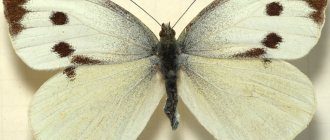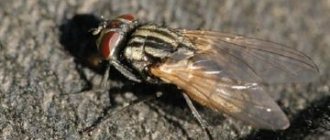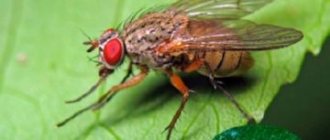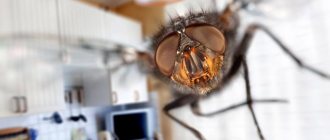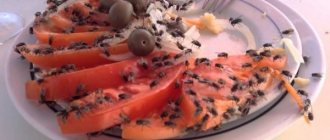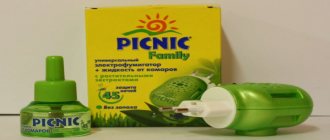The cabbage fly is an insect pest. Its larvae damage the root system of cruciferous plants, which leads to rapid wilting of cabbage. It is problematic to remove this fly, so gardeners advise taking certain preventive measures that will help avoid its appearance. But such actions do not always give a 100% guarantee, as a result of which you need to know the signs of a plant being damaged by this insect and methods of its destruction.
Appearance of cabbage fly
There are 2 types of pests that differ only in size - spring and summer flies.
Main characteristics of the appearance of an adult pest:
- coloring is ash-gray, and in males it is slightly darker;
- length - 6 mm (spring), 7.5 mm (summer) and 5.5 mm (males);
- the abdomen has an elongated ovoid shape with a pointed apex;
- a wide black stripe runs along it. At the base it widens, and towards the posterior edge of the segments it narrows;
- there are 3 dark longitudinal stripes on the back;
- in males there is a narrow transverse dark stripe on each segment, and in females there are wedge-shaped spots of brown color;
- The width of the eyes of females is equal to the width of the forehead, and in males it is 4-5 r. more;
- In females there is 1 hair at the base of the hind thighs, while in males there are many more.
Insect larvae have a thick yellow or white body measuring 8 mm.
It is narrowed in front and ends in an oblique cut at the back. Two symmetrical black hooks are visible through the transparent cover of the head end. Important!
Damage to cruciferous crops is caused by the larvae, and not the adults, of cabbage flies, since they are the ones who feed on the green roots of cabbage, damaging their integrity.
Reasons for appearance
From late April to mid-May, female spring flies begin to lay eggs (each individual about 150 pieces) on or near the root collar of cabbage in the surface layer of soil. The peak of this process is considered to be the time of lilac flowering. The soil temperature should be 9-10 degrees. After 7-10 days, larvae emerge from them. They feed on the green roots of the plant and destroy the core of the stems.
Summer flies appear towards the end of the first summer month, when the air temperature exceeds 18 degrees, so their larvae pose a threat to the harvest of late cabbage.
The factors that contribute to the occurrence of the pest in household plots are unknown, so gardeners recommend periodically inspecting the planted crop for the presence of cabbage fly eggs. This will help to take timely measures to destroy them and save, if not the entire harvest, then most of it.
When the larvae appear, it will be much more difficult to save the cabbage. They quickly begin to absorb its roots and the plant completely withers in 3-4 weeks.
Biology
Both species belong to the family of flower flies, so named because the time of their flight coincides with the beginning of flowering of most of our trees, in particular cherries. They are similar to our house flies, only slightly smaller. Some authors consider flies to be one species, others classify them as different, but this does not reduce the harmfulness of insects and from the point of view of a gardener their classification is not important.
I have an opinion! It has been suggested that the summer fly is simply a descendant of the spring fly, but given that their activity occurs at the same time, it is worth arguing that these are two similar species.
The assertion that we are dealing with different insects is also supported by the fact that the appearance of a summer fly, which does not affect the planting of early cabbages, harms the planting of seedlings of late varieties, but the difference between the planting of seedlings is small, and the generation cycle of the cabbage fly simply does not have time to complete .
Nutrition
As a pest, the cabbage fly manifests itself in the larval stage, a sort of cabbage maggot, while the adult insect feeds on flower nectar, being a pollinator of cruciferous plants, that is, in a sense, a beneficial insect.
Reproduction and development
The flight of flies, as mentioned above, begins during the flowering of bird cherry and cherry; the summer variety flies out another week later than the spring one. Two days after the start of summer, insects mate.
A week or two after mating, females lay eggs on the soil under plantings of cruciferous crops; in years of mass damage, a female is capable of laying up to three hundred (!) eggs. After 5-10 days, the larva appears and begins its harmful existence.
The larva of the cabbage fly penetrates the root membrane of the cabbage plant and either remains under the outer membrane of crops with a simple root, or gnaws into the root crop of the corresponding plants:
- radishes;
- turnips;
- rutabaga;
- turnip;
- radishes;
- daikon
The larva develops within three to four weeks, depending on temperature conditions, then emerges from the plant and pupates in the soil. The pupa develops 15-20 days before the adult insect emerges. The second generation papuary goes into winter, overwintering in the soil at a depth of 15-20 centimeters.
Reference! Papuary, or pupa, is the stage of insect development with the complete transformation of the larva into the adult. At this stage, a complete restructuring of the insect’s body occurs.
Signs of appearance
If you notice that cabbage flies are starting to fly over your seedlings, then they are either preparing to lay eggs, or have already done this and you need to take action to eliminate them. Summer residents do not always notice this moment and the hatched larvae begin to gnaw through the roots of the plant, which will be indicated by the following signs:
- the cabbage looks wilted. Some believe that this indicates insufficient soil moisture;
- after excessive watering there is no change. The plant continues to wither because its vessels are damaged and moisture does not flow through them;
- bluish-lead leaves.
If any sign of damage to a garden crop by cabbage fly is detected, action to combat it must not be postponed, otherwise the harvest will be lost.
Effective folk remedies
To solve this problem, various chemicals are produced (Zemlin, Karbafos, Lepidotsid, Actellik), but in their absence or to increase efficiency, it is recommended to use folk methods:
- wash the seedlings in weak potassium permanganate before planting;
- plant plants that emit odorous elements (garlic, sage, celery, cumin, marigolds) in the spaces between the cabbage or along the perimeter of the garden bed;
- spray the flaccid plant heads with an aqueous solution of ammonia (5 ml per 10 liters of water) or burdock infusion (2.5 kg of leaves are placed in 9 liters of warm water and left for 48 hours);
- sprinkle the cabbage with a small amount of a mixture made from ground hot pepper and mustard powder;
- in mid-May, dust the soil with naphthalene mixed with sand in equal proportions, at a distance of 5 cm from the seedlings. When eggs are detected, 6 g of this mixture is added under each stem, 1 r. in 8 days. This destruction measure is carried out 3 times;
- bury wood ash in the ground near the cabbage or apply dry ash to the plant itself. The procedure is repeated 1 day. at 5 days;
- around the root collar the soil is covered with camphor, slaked lime or wood ash mixed with shag;
- remove old soil and add new soil, taken from another place, to the stem;
- Dust wet cabbage leaves with the dusty mixture. To prepare it, mix shag and wood ash in equal parts. The procedure is carried out when morning dew appears or in the evening;
- spray the seedlings with a solution of valerian (40 ml per 3 liters of water) with the addition of grated laundry soap (2 tablespoons). Soap shavings must be stirred until dissolved;
- For spraying the crop, an aqueous solution of 70% vinegar essence or 9% vinegar (0.5 cups per bucket of water) is suitable.
It is also recommended to install a barrier using a translucent mesh (Lutrasil, Agril). It is pulled over the beds, tightly attached to the ground so that there are no gaps. When it rains, the net is allowed to be removed, since insects do not fly. Watering is carried out without removing such a barrier.
Important! You can install special lids made of plastic or cardboard under the cabbage. They make a cutout for the stem. These devices will prevent flies from laying eggs near the root collar.
Insecticides and traditional methods solve the problem, but they must be used before planting the cabbage in the ground and periodically as it grows. If you miss the moment of appearance of the larvae and their further transformation into pupae, then growing the crop will be problematic due to the birth of new generations of cabbage flies.
Prevention
To avoid damage to garden crops by such insect pests, preventive measures have been developed:
- follow the rules of crop rotation (cabbage should not constantly grow in the same beds);
- remove plants that have arrows;
- take measures to prevent the emergence of wild cruciferous plants that are weeds (sverbiga, rapeseed);
- cleaning the area from cabbage tops and leaves, as well as their subsequent disposal outside the garden;
- ensure that pest larvae are not introduced into the soil along with the seedlings;
- periodically carry out deep plowing of the beds in which cabbage grew. This will allow you to destroy the maximum number of pupated larvae;
- remove the surface layer of soil (10 cm), replacing it with fresh soil taken from another territory;
- treat the roots of the seedlings before planting with weak potassium permanganate;
- plant calendula, parsley, celery, coriander and other plants that produce odorous elements that repel flies between the cabbage or along the perimeter of the bed.
These simple steps will help prevent the appearance of cabbage fly larvae, which will protect your crop from damage.
The main mistakes of gardeners
Very often, inexperienced gardeners make a number of mistakes that provoke the appearance of cabbage flies in the beds.
- Planting a crop for several years in one place.
- Location next door to radish cabbage.
- Planting seedlings in untreated soil.
- The soil has not been updated. Before planting cabbage, 10-15 cm of soil should be removed and new soil should be added, which must first be disinfected.
If there is no control, the cabbage fly quickly destroys the crop
. You need to get rid of the cabbage fly promptly. If it is not possible to prevent the appearance of a dangerous pest, quickly treat the affected seedlings with special insecticides. Often traditional methods are much more effective.
Adviсe
To detect pest eggs, it is recommended to dig up the soil at the root collar using a fork. If you notice small white spots, they need to be carefully removed from the stem before the larvae appear.
According to the advice of gardeners who are faced with this problem, you should not constantly plant cabbage in the same bed. This will increase the risk of cabbage fly. It is also not recommended to plant radishes near them, as the pest is very fond of this plant. Before planting seedlings, first carry out deep plowing and be sure to update the top layer of soil.
The larvae cause great damage to cruciferous plants, so the main rule in the fight against cabbage fly is to take preventive measures. This will not only protect the harvest, but also reduce the risk of insect infestations in subsequent years. If you missed the right moment and the pest began to spoil your cabbage, then try to quickly destroy it.
Choosing the Right Method
You can fight cabbage fly and its larvae with folk remedies or store-bought preparations. However, you need to take into account the cabbage variety and growing season.
- For early varieties, poison should not be used.
- Processing of medium varieties is allowed at the seedling planting phase; later, folk remedies are used.
- Insecticides can be used on late cabbage, but the last treatment of the plant should be carried out no later than 25 days before harvest.
Chemical preparations allow you to get quick results in a matter of days, while the use of folk remedies requires systematic repetition. The crop should be sprayed or watered regularly every 3-5 days. The effectiveness of the procedure is evidenced by the rapid growth of the plant and the setting of heads of cabbage without deformation. Otherwise, the fight must continue.
Folk remedies can be used at any stage of the plant’s growing season; a combination of several recipes is allowed. The effect of the chemical product lasts for up to 60 days when watered, and for 30 days when sprayed. The procedure should be carried out in dry weather in the morning or evening.

